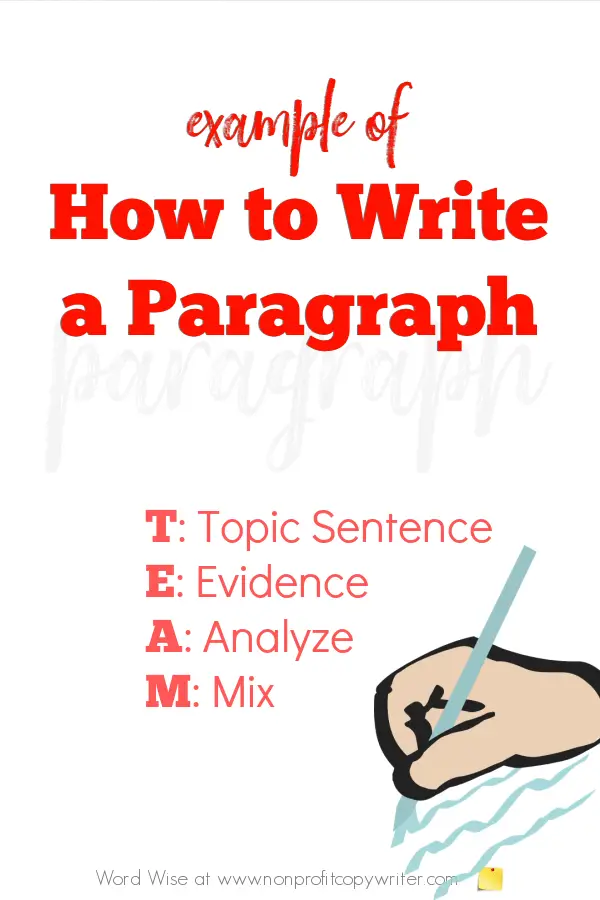Save Time: Get 5 Simple Writing Tips
you can put to use in 10 minutes
How to Write a Paragraph: Rules to Keep and One to Break
Award-winning writer Kathy Widenhouse has helped hundreds of nonprofits and writers produce successful content , with 750K+ views for her writing tutorials. She is the author of 9 books. See more of Kathy’s content here.
Your earliest language arts teacher drilled into your head how to write a paragraph. She had clear steps for writing a good paragraph that she insisted you follow. The goal? A clear, organized presentation.
Always start, she said, with a topic sentence. Then add a sentence or two or three to explain your main point further.
By all means, make sure to write at least 3-5 sentences per paragraph – up to eight – so that your content is substantial. And those sentences? Each one must have a noun and a verb. When you’ve supported your topic sentence, write a transition sentence to the next paragraph.
And then repeat the process until you finish your essay, report, or paper.
Another Example of How to Write a Paragraph
Or maybe you learned the steps in writing a good paragraph by using the TEAM acronym:
- T: Topic sentence. Write out the main idea at the beginning of the paragraph.
- E: Evidence. Give quotes, paraphrases, or facts to reinforce the topic sentence – generally, anything that is not your own idea.
- A: Analysis. Discuss your own thoughts about the topic sentence, in light of the evidence.
- M: Mix. Summarize your point and then transition to the next paragraph.
Same idea, right? Plus, by using the TEAM acronym with its four points, there’s a good chance you’ll write a minimum of four sentences. That falls smack in the middle of the 3-5 minimum-number-of-sentences zone.
To be truthful, both of those approaches work well for writing paragraphs. Most of the time, that is.
The Paragraph Rule That Writers Break the Most
The rise of conversational writing, especially online, brushes aside one of your language arts instructor’s cardinal rules when she was teaching you how to write a paragraph.
The rule? A paragraph must have 3-8 sentences.
No longer true, say the language scholars at the University of North Carolina. “In some styles of writing, particularly journalistic styles, a paragraph can be just one sentence long,” explain the UNC Writing Center’s experts. “Ultimately, a paragraph is a sentence or group of sentences that support one main idea.”
Eureka! I don’t need to write eight sentences or even three in a block of text. A paragraph can consist of two sentences, or even just one. The deciding factor is whether or not that paragraph communicates a complete idea.
Going a step further, since a single word can be a sentence, you can literally have a paragraph that consists of a single word.
Nice!
Shorter Paragraphs Are Not Always Best
Are shorter paragraphs the “new normal”? It depends. Naturally, there are a few instances when shorter paragraphs are not only acceptable but embraced.
- In online content. Digital writing is skimmable, with lots of white space, subheads, bullet points, and yes – short paragraphs.
- In commercial content. Short paragraphs are typical fare in copywriting. Ads, sales pieces, email marketing messages, presentations, and social media campaigns are packed with one- and two-sentence paragraphs.
- In dialogue. Fiction writers know to hit the “Return” button and start a new paragraph every time a different character contributes to the on-paper conversation.
Yet there are clear instances when 3+ sentences per paragraphis expected.
- In academic writing. Scholarly articles, research, literary reviews, official documents, and legal briefs are situations in which the TEAM paragraph format is appropriate or even required.
- When the editor says so. Some publications, (like The Writing Cooperative, for instance), request restraint with overusing one- or two-sentence paragraphs.
How to Write a Paragraph Regardless of the Type of Project
Whether you’re writing a doctoral thesis or a quick blog post, your goal doesn’t change in writing a paragraph. It's to write a clear, organized presentation.
That can happen with well-structured, 3-8 sentence paragraphs. And it can happen with short, snappy one- or two-sentence paragraphs punctuated with longer ones in between.
The key? Clarity and organization. No matter how many sentences you write in each paragraph.
More Content Writing Tips
How to Write an Introduction (or Lead, Lede, Hook) ...
How To Write An Opening Paragraph for Your Blog Post ...
How to write a conclusion: 3 tips ...
How to Write a Thesis Statement ...
3 Tips for Writing Conversationally Online (and Off) ...
More Tips for Writing Content on our Pinterest board ...
Return from How to Write a Paragraph to Nonprofit Copywriter home
As an Amazon Associate I earn from qualifying purchases.
Share This Page

Named to 2022 Writer's Digest list
BEST GENRE/NICHE WRITING WEBSITE


Stop Wasting Time!
Grab your exclusive FREE guide, "5 Simple Writing Tips You Can Put to Use in 10 Minutes or Less"












